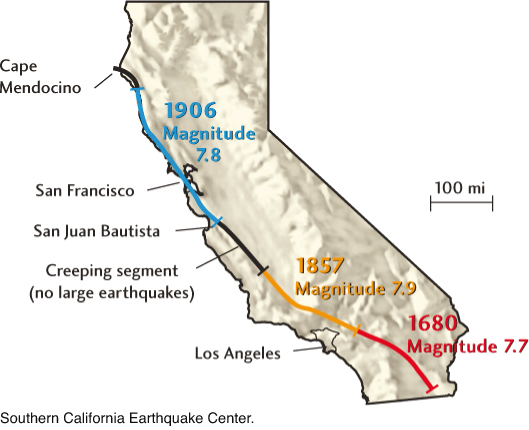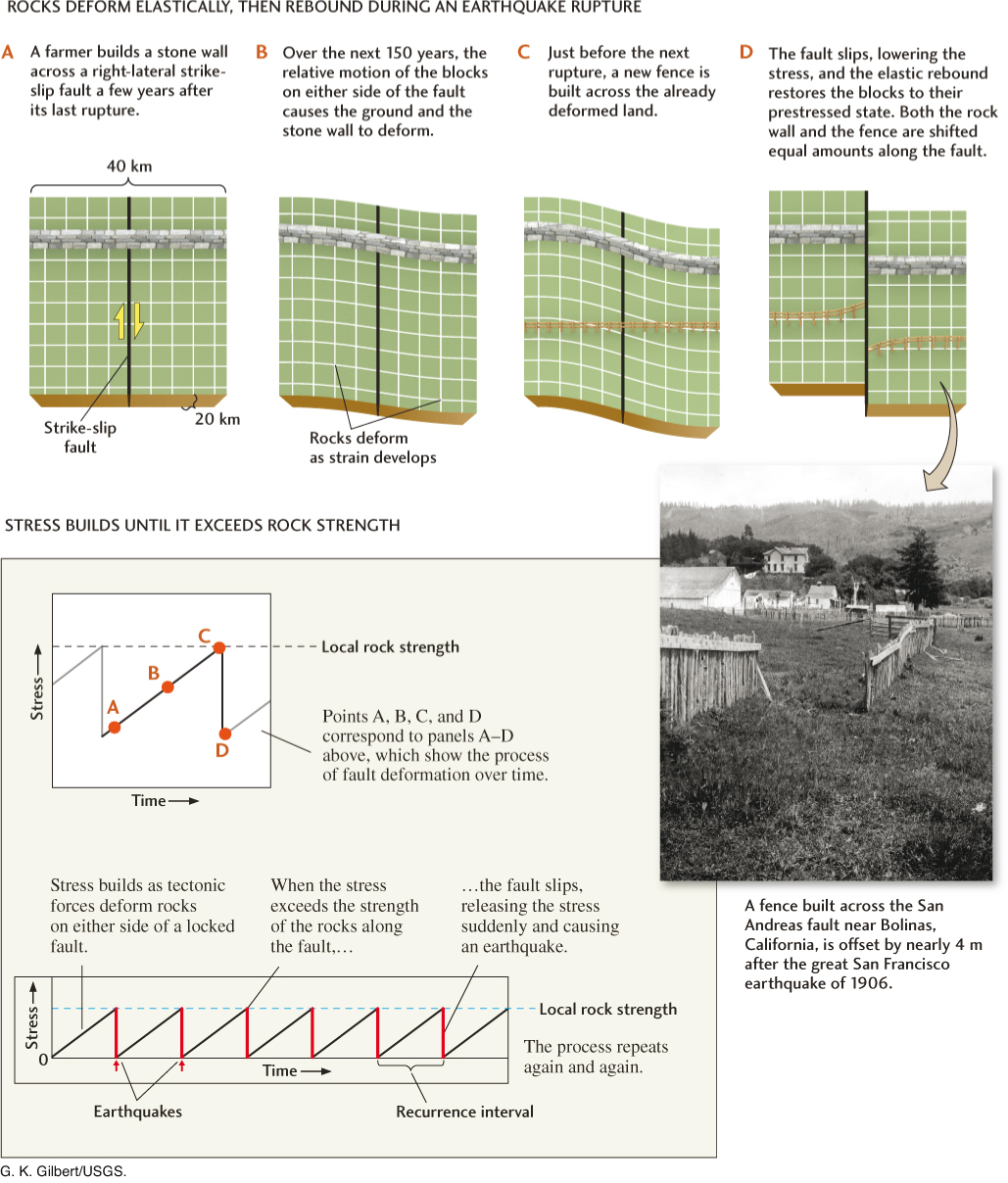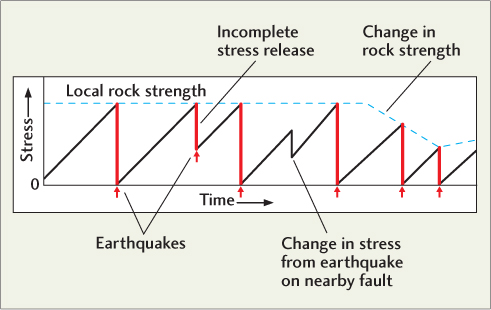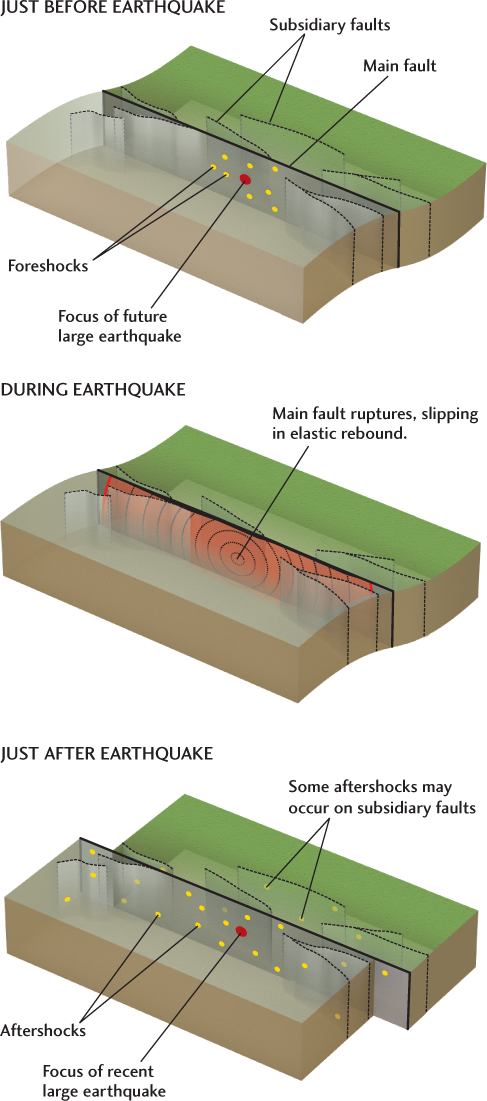What Is an Earthquake?
The movement of lithospheric plates generates enormous forces at the boundaries between those plates, as we saw in Chapter 7. These forces deform brittle crustal rocks in ways that can be described by the concepts of stress, strain, and strength. Stress is the local force per unit area that causes rocks to deform. Strain is the relative amount of deformation, expressed as the percentage of distortion (for example, compression of a rock by 1 percent of its length). Rocks fail—that is, they lose cohesion and break into two or more parts—when they are stressed beyond a critical value, called their strength.
An earthquake occurs when rocks under stress suddenly fail along a geologic fault. Most large earthquakes are caused by ruptures of preexisting faults, where past earthquakes have already weakened the rocks on the fault surface. The two blocks of rock on either side of the fault slip suddenly, releasing energy in the form of seismic waves, which we feel as ground shaking. When the fault slips, the stress is reduced, dropping to a value below the rock strength. After the earthquake, the stress begins to increase again, eventually leading to another large earthquake. The faults involved in this repeated earthquake cycle are called active faults, and they are concentrated in the zones that form plate boundaries, where most of the stress and strain caused by plate movements is concentrated.
349
The Elastic Rebound Theory
The earthquake on the San Andreas fault that devastated San Francisco in 1906 was studied more than any earthquake had been up to that time. By mapping the displacement of the ground across the fault and analyzing seismic recordings of the earthquake, geologists showed that this rupture began just west of the Golden Gate and propagated along the fault strike for over 400 km, southeastward to the mission town of San Juan Bautista and northwestward all the way to Cape Mendocino (Figure 13.2). In 1910, one of the scientists who studied this rupture, Henry Fielding Reid of Johns Hopkins University, advanced the elastic rebound theory to explain how earthquakes recur on active faults in Earth’s crust.

Picture a strike-slip fault between two crustal blocks, and imagine that surveyors have painted straight lines on the ground, running perpendicular to the fault and extending from one block to the other, as in Figure 13.3a. The two blocks are being pushed in opposite directions by plate movements. The weight of the overlying rock presses them together, however, so friction locks them in place along the fault. They do not move, just as a pushed car does not move when the emergency brake is engaged. Instead of slipping along the fault as stress builds up, the blocks are strained elastically near the fault, as shown by the bent lines in Figure 13.3b. By elastically, we mean that the blocks would spring back and return to their undeformed, stress-free shape if the fault were suddenly to unlock.

As the slow plate movements continue to push the blocks in opposite directions, the elastic strain in the rocks—measured by the bending of the survey lines—-continues to build up over decades, centuries, or even millennia (Figure 13.3c). At some point, the strength of the rocks is exceeded. Somewhere along the fault surface, the frictional bond that locks the fault can no longer hold, and it breaks. The blocks slip suddenly in a rupture that starts at a point but quickly extends over a section of the fault.
Figure 13.3d shows how the two blocks have rebounded—sprung back to their undeformed state—after the earthquake. The bent survey lines have straightened, and the two blocks have been displaced. (Note that a fence built just before the rupture has been bent during the rebound.) The distance of the displacement is called the fault slip. In the inset photograph of Figure 13.3, you can see that the fault slip during the 1906 earthquake was about 4 m. The peak velocity of the slipping at any point on the fault is about 1 m/s, so the entire episode of fault slipping at a given point takes only a few seconds. After the fault has slipped, it locks up again. The steady movement of the blocks on either side of the fault then causes stress to rise again, and the earthquake cycle repeats.
The energy that is slowly built up by elastic strain as the two blocks are pushed in opposite directions is like the elastic energy stored in a rubber band when it is slowly stretched. The sudden release of energy when a fault slips is like the violent backlash, or rebound, that occurs when the rubber band breaks. Some of this elastic energy is radiated in seismic waves, which can cause violent shaking many kilometers away from the fault.
The elastic rebound theory implies that there should be a periodic buildup and release of elastic energy at faults, and that the time between ruptures, called the recurrence interval, should be a constant (as shown in the bottom panel of Figure 13.3). The recurrence interval can be calculated by dividing the fault slip in each rupture by the long-term slip rate. The long-term slip rate on the San Andreas fault is about 30 mm/year, for example, so earthquakes with 4 m of slip should occur with a recurrence interval of about once every 130 years.
However, most active faults, including the San Andreas, do not conform to this simple theory. For instance, all of the strain accumulated since the last earthquake may not be released in the next—that is, the rebound may be incomplete—or the stress on one fault may change because of earthquakes on nearby faults (Figure 13.4). Over the long term, the strength of the fault rocks themselves may change. These irregularities are some of the reasons why earthquakes are so difficult to predict.

350
351
Fault Rupture During Earthquakes
The point at which fault slipping begins is the focus of an earthquake (Figure 13.5). The epicenter is the geographic point on Earth’s surface directly above the focus. For example, you might hear in a news report, “The U.S. Geological Survey reports that the epicenter of last night’s destructive earthquake in California was located 6 kilometers east of Los Angeles City Hall. The depth of the focus was 10 kilometers.”

The focal depths of most earthquakes in continental crust range from 2 to 20 km. Continental earthquakes below 20 km are rare because under the high temperatures and pressures found at those greater depths, continental crust behaves as a ductile rather than a brittle material (just as hot wax flows when stressed, whereas cold wax breaks; see Chapter 7). In subduction zones, however, where cold oceanic lithosphere plunges into the mantle, earthquakes can originate at depths of almost 700 km.
The fault rupture does not happen all at once. It begins at the focus and expands outward along the fault surface, typically at 2 to 3 km/s (see Figure 13.5). The rupture stops where the stresses become insufficient to continue breaking the fault (where the rocks are stronger) or where the rupture enters ductile material in which it can no longer propagate. As we will see later in this chapter, the magnitude of an earthquake is related to the total area of fault rupture. Most earthquakes are very small, with rupture dimensions much less than the depth of the focus, so that the rupture never breaks the ground surface.
In large, destructive earthquakes, however, surface breaks are common. The 1906 San Francisco earthquake caused surface displacements averaging about 4 m along the 470-km section of the San Andreas fault that ruptured in that event (see the inset of Figure 13.3). Fault ruptures in the largest earthquakes can extend for more than 1000 km, and the fault slip can be tens of meters. Generally, the longer the fault rupture, the greater the fault slip.
As we have seen, the sudden slipping of the blocks at the time of the earthquake reduces the stress on the fault and releases much of the stored elastic energy. Most of this stored energy is converted to frictional heat in the fault zone or dissipated by rock fracturing, but part of it is released as seismic waves that travel outward from the rupture, much as waves ripple outward from the spot where a stone is dropped into a still pond. The focus of the earthquake generates the first seismic waves, but slipping parts of the fault continue to generate waves until the rupture stops. In a large event, the propagating rupture continues to produce waves for many tens of seconds. These waves can cause destruction in regions all along the fault rupture, even far from the epicenter. Towns along the San Andreas fault far north of San Francisco were badly damaged in the 1906 earthquake.
Foreshocks and Aftershocks
Almost all large earthquakes trigger smaller earthquakes called aftershocks. Aftershocks follow the triggering event, or mainshock, in sequences, and their foci are distributed in and around the rupture surface of the mainshock (Figure 13.6). Aftershock sequences exemplify the complexities of earthquakes that cannot be described by simple elastic rebound theory. Although fault slipping during the mainshock decreases the stress along most of the rupture surface, it can increase the stress on parts of the fault surface that did not slip, or where the slip was incomplete, as well as in surrounding regions. Aftershocks happen where that stress exceeds the rock strength.

The number and sizes of aftershocks depend on the magnitude of the mainshock, and their frequencies decrease with time after the mainshock. The Aftershocks of a magnitude 5 earthquake might last for only a few weeks, whereas those of a magnitude 7 earthquake occur over a larger region and can continue for several years. The size of the largest aftershock is generally about one magnitude unit smaller than the mainshock. According to this rough rule of thumb, a magnitude 7 earthquake might have an aftershock as large as magnitude 6.
In populated regions, the shaking from large aftershocks can be very dangerous, compounding the damage caused by the mainshock. On September 4, 2010, a magnitude 7.1 earthquake west of Christchurch, the second largest city in New Zealand, caused extensive damage, but nobody was killed and only a few people were injured. However, a magnitude 6.3 aftershock struck right beneath the center of Christchurch on February 22, 2011, collapsing buildings and killing 185 people (Figure 13.7). The economic losses from this aftershock, estimated at $15 billion, were several times greater than the losses caused by the mainshock five months before. Other strong aftershocks hit the city on June 13 and December, 2011, injuring dozens and causing $4 billion in additional damages. More aftershocks can be expected in the years to come.

352
353
A foreshock is a small earthquake that occurs shortly before a mainshock, near its focus (see Figure 13.6). One or more foreshocks have preceded many large earthquakes, so scientists have tried to use foreshocks to predict when and where large earthquakes might happen. Unfortunately, it is usually very hard to distinguish foreshocks from other small earthquakes that occur randomly and frequently on active faults, so this method has only rarely proved successful. The magnitude-9 Tohoku earthquake that caused a great tsunami to hit Honshu, Japan on March 11, 2011 (see Earth Issues 13.1), was preceded by a foreshock of magnitude 7.2 about 50 hours before the mainshock. In some sense, the mainshock was an anomalously big “aftershock” associated with the first event. But what turned out to be a foreshock was considered at the time to be only an ordinary magnitude-7.2 earthquake in the subduction zone.
As this example illustrates, foreshocks, mainshocks, and aftershocks can be classified in a definitive way only after the earthquake sequence has ended; during the sequence we cannot be sure whether the mainshock—the biggest event in the sequence—is yet to come.